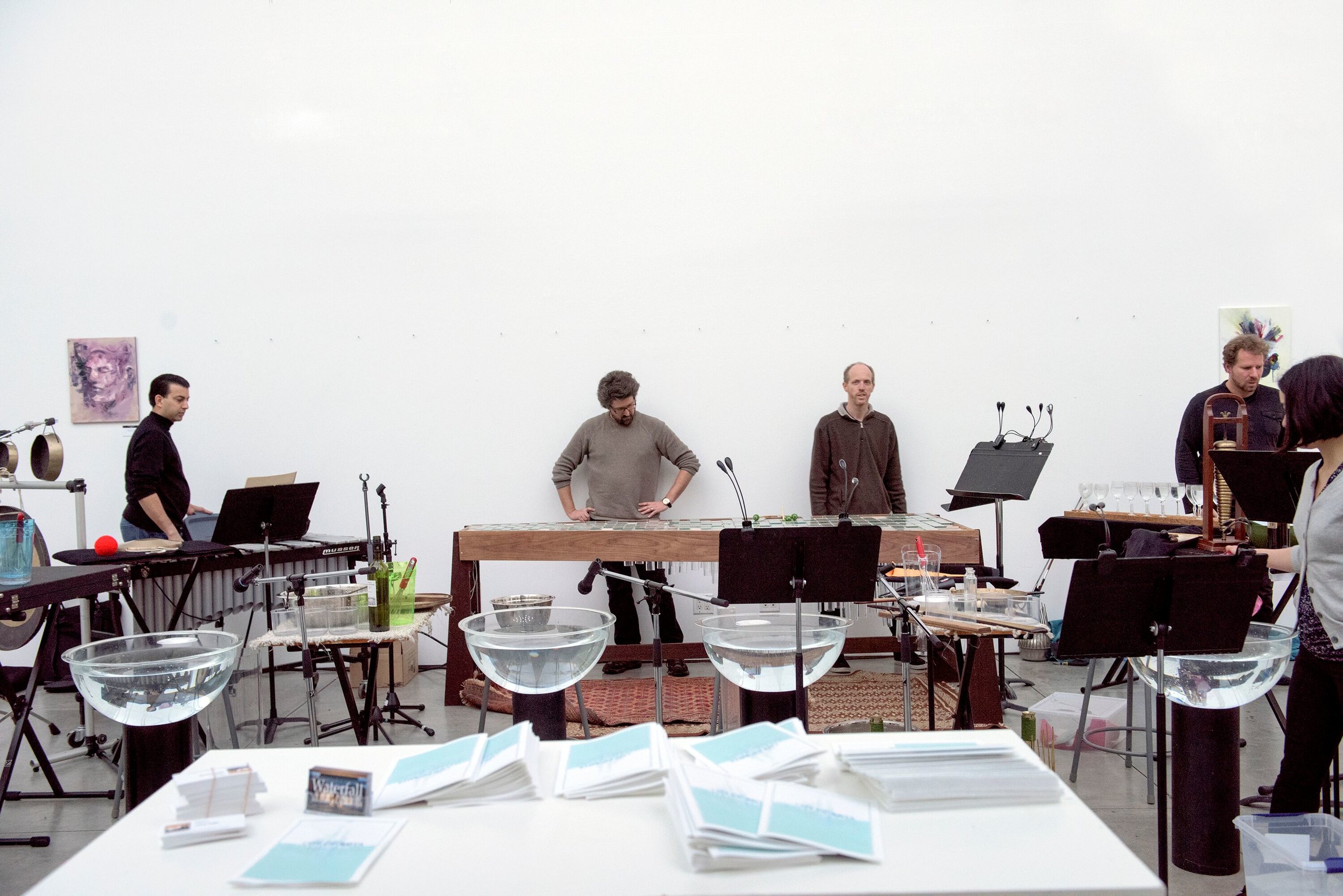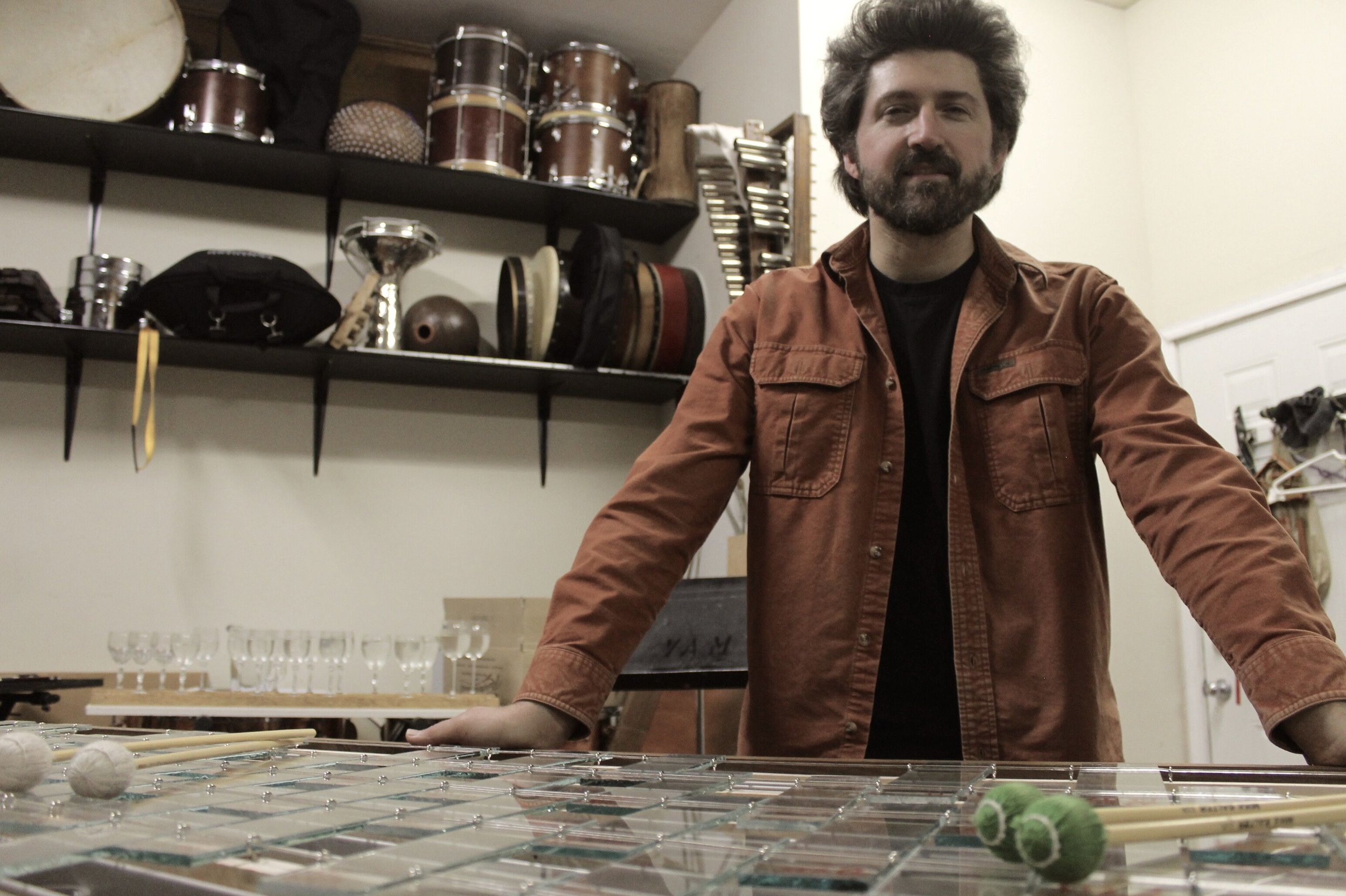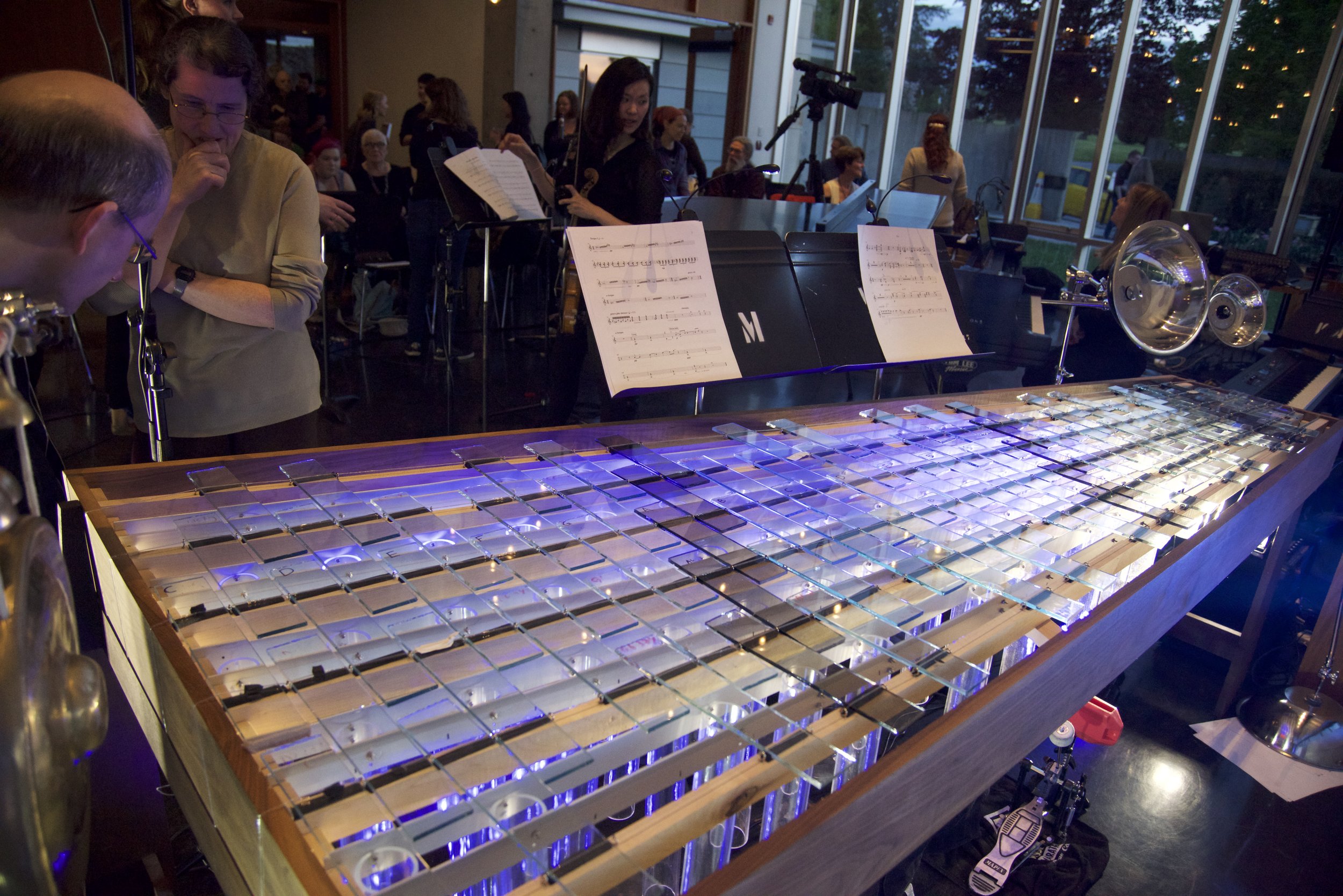INNOVATOR
THE LUMATONE
Instrument designer: Dylan Horvath
Commissioner: Lumatone Inc
Composer and Brand Ambassador: Benton Roark
Video: Matt Angus
Notes: The Lumatone is an isomorphic controller with fully customizable LED and midi-mapping. I was asked to be one of several composer-performers and brand ambassadors for the instrument in 2019, when I composed Sundog (above), which is written in 31-tone equal temperament on a mapping I designed for the instrument. The keyboard is being launched in 2020.
Visit www.lumatone.io for more information.
THE LUMIPHONE
Instrument designer and builder: Benton Roark
Producer and commissioner: Redshift Music Society
Special thanks to: Robert Gill (stand); Darryl Wise (carpentry); Joel Bagnal (glass); Robert Studer (design); Randal Roark (design)
Photography: Chris Randle; Brian Cyr (far right and home page)
Notes: The Lumiphone is a three-octave (C4-C7) glass marimba tuned to 31-tone equal temperament. It was designed and built between 2014 and 2016 and was premiered at City of Water, Sea of Glass (see “producer”).
Press:
Unusual Instruments at Jazz Fest
Jocelyn Morlock at Sam Sullivan’s Salon
The following is quoted from “The Glass and Water Verve” (Benton Roark, author), published in Megaphone Magazine, May 24. 2016.
Armed with a car full of walnut and maple planks, a box full of plate glass bars, and a diamond bit grinder, I drove from Florida to Vancouver in January 2015 to assemble the prototype of a new musical instrument: a giant glass marimba.
The prospect of a new instrument and the different kind of music it might make was exhilarating, but there were bound to be some challenges. The main one, I knew, was going to be whether the musicians charged with playing it could adapt to its alternative tuning system. As anyone who has practiced western music will know, we learn how to play music in a scale that has 12 notes per octave, each more or less associated with a fixed frequency. The scale I was using had 31.
My imagination is what got me into all this. I suppose the initial inspiration came from Harry Partch, the American composer and boxcar-riding, iconoclast instrument builder. This guy took on everything—math and science, music with more than 12 notes in an octave (microtonal), ritualistic drama, new instrument design—and fused it all into a creative vision that hovered on the outskirts of culture in economically depressed pre-war America.
Play lively and fast
Partch had built a marimba to play his music. I could do the same, I thought, but I would attempt to do so with a different tuning system in mind. One of my objectives was to try and harness the beautiful soundscape of the city in which I live, Vancouver. Vancouver’s soundscape ranges from the muted drips of the rain to the echoes of foghorns across water to the refractions of urban noise off glass skyscrapers. It was from here that the guiding themes of water and glass emerged to inspire a collection of new instruments and a larger project that would encompass them.
Part of getting new ideas off the ground, I’ve learned, is engaging the community.
I mentioned my idea for a microtonal marimba to my colleague at Redshift Music Society, Jordan Nobles, who agreed to get behind the project. City of Water, Sea of Glass, as the project came to be called, was at the heart of many ideals he had been championing with Redshift—most importantly that an audience should feel connected to their environment through the music they are hearing. Glass and water are representative of Vancouver in their physical composition and acoustic qualities: they are pure in timbre, have reverberant sustain, and create a certain ambiance with their colour. Giorgio Magnanensi, of Vancouver New Music, put me in touch with his neighbour on the Sunshine Coast, sculptor and designer Robert Studer. Among other Vancouver landmarks, he made the glassand- steel sculpture that hangs in the lobby of downtown’s Cathedral Place.
With Studer on his way to Southeast Asia for a year, we talked shop via email and glitchy Skype connections. He would send me sketches of new instrument ideas inspired by his travels (for example, the beautiful “Rainbow” instrument which he would build in time) and point me in the direction of people in town that could collaborate with us on the project.
Birth of a new instrument
Shortly after Studer left for Thailand, I completed an artist residency at the Atlantic Center for the Arts in Florida, which found me writing music as well as cutting and testing a series of glass bars (or “keys” in marimba-speak) that would form the initial pitch collection of my instrument. In Florida, I became acquainted with a thriving artist community dedicated to glass, metal, and woodwork (that’s how the maple and walnut ended up in my car). These collaborators were happy to share their knowledge, not to mention their power tools. I shouldn’t forget the various auto glass shops that, in exchange for a few dollars and the occasional case of beer, cut pieces of scrap glass for future marimba keys.
During my time down there I quickly fell in love with a different kind of work than I am used to as a composer. Don’t get me wrong. I love writing music—dreaming up sounds, conveying them in arcane symbols on paper, hearing the music they denote eventually fill up a concert space.
But building things—that tangible aspect of using your hands, seeing the results quickly, and simply being more physically active with your work—turned me into a denizen of the visual arts world.
The end result of these collaborations was a successful marriage of visual arts and music in the form of two instruments: the Rainbow, a tree of tapering coloured glass bowls designed by Studer using blown glass by Heather Konschuh, and my marimba, which I named the Lumiphone. The concepts of light, reflection, and colour were always intrisincally tied to my vision for the instrument, and so the name combines two roots derived from ancient terms for light (“lumi”) and sound (“phone”).
Debut of glass and water
I always knew building the instruments was just the tip of the iceberg. The real challenge was going to be integrating them into actually making music in a way that was convincing for audience members and appealing to performers (admittedly, we targeted the more adventuresome set). At one particular development workshop with the marimba and strings, we spent nearly an hour just tuning chords within the 31-tonesper- octave scale, at the end of which I heard one musician exclaim, “Ow, my brain hurts!”
New music that showcased our visual and sonic creations had to be written, and to this end Redshift engaged composers Chris Reiche, Nova Pon, Christiaan Venter, and Mariah Mennie to write works for our City of Water, Sea of Glass concert. We also included pieces such as New York-based Viet Cuong’s Water, Wine, Brandy, Brine, a work that calls for percussionists to perform an intricate interplay of 15 tuned wine glasses. I’ll never forget Nobles and his son, Julian, trying out every single wine glass at the Richmond IKEA in preparation for the show. They tapped them, rubbed them, and swirled them full of water from the food court, all to the relative aloofness of young couples intent on their soon-to-be-acquired kitchen sets.
City of Water, Sea of Glass played at the Waterfall Building near Granville Island on Jan. 29 to a sold-out house, tightly tucked around the large percussion installation of delicate glassware and vessels filled with water that eventually would leave concertgoers a touch soggy. As producers, much of our work was done by the time the downbeat fell, leaving little to do but sit back, enjoy the ride, and pray that not too much would break along the way.
For a show like this, though, breaking a thing or two and getting some people wet (recall the Redshift mandate of connecting audience to their environment) was all part of the fun.
What’s next for Redshift? The spring will see a mixture of site-specific and avantchamber fare, and we have plans to give other composers a chance to write music for the Lumiphone. In the wake of water and glass, though, we’re already looking to next season.
Maybe fire and air? City of Water, Sea of Glass was a significant milestone in my quest to offer a new way of making and listening to music. The project made its first splash. I’m looking forward to seeing where it goes.
-Benton Roark



